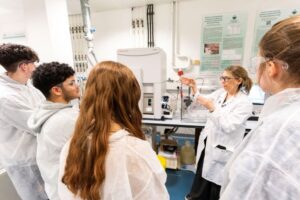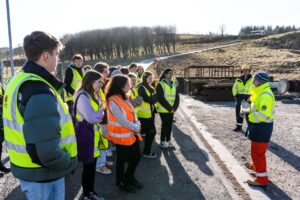News story: New members appointed to the Council for Science and Technology
Two new members have been appointed to the Prime Minister’s Council for Science and Technology.
Two new members have been appointed to the Prime Minister’s Council for Science and Technology.
Scientists of the future got to see at first hand the excellent work that goes on at the Health and Safety Executive’s (HSE) Science and Research Centre in Buxton.
 A-Level students from Meadowhead School in Sheffield spent time at the specialist facility meeting HSE scientists and hearing from them about their careers, career paths and academic route into science.
A-Level students from Meadowhead School in Sheffield spent time at the specialist facility meeting HSE scientists and hearing from them about their careers, career paths and academic route into science.
The visit, organised by HSE, encourages students to think about science, technology, engineering, and maths (STEM) as a future career.
A group of 21 students started the day with a tour of the wider site, looking at the experimental facilities and test rigs and received an overview of the type of projects and science-based work that has been conducted in Buxton over the years.
Smaller groups of students based on their A-level choices then spent time with relevant specialists including engineers, biochemists, fire and explosives specialists, analytical chemists, human factors specialists, toxicologists, noise and vibration specialists, ventilation specialists, and microbiologists.
Professor Andrew Curran, HSE’s Director of Science, said: “We are very proud of all our facilities and our specialist scientists, engineers and analysts at Buxton and this visit allowed students to speak to our inspirational scientists who were able to showcase some of their work first hand.
 “We hope we’ve helped broaden the students’ views of hands-on science, technology, engineering, and maths by showing them areas of work they may not have considered before and how rewarding a career in STEM can be.
“We hope we’ve helped broaden the students’ views of hands-on science, technology, engineering, and maths by showing them areas of work they may not have considered before and how rewarding a career in STEM can be.
“Visits like this are really important as they can trigger a ‘wow’ moment for a student which inspires them to take a new direction in their career.”
HSE’s Science and Research Centre is set on a 550-acre site in Buxton, Derbyshire, and accommodates an impressive inventory of laboratory and large-scale testing facilities.
Around 380 scientists, engineers, occupational health and hygiene specialists and support professionals are based at the site. Here they provide the research and evidence that HSE requires to underpin its regulatory activities, protect people and places and make Great Britain one of the safest places in the world to work.
 Cerys Evans, careers leader at Meadowhead school and sixth form, added: “Students were keen to find STEM-related work experience, but were struggling to find the right settings within travelling distance, which is where the team at HSE stepped in.
Cerys Evans, careers leader at Meadowhead school and sixth form, added: “Students were keen to find STEM-related work experience, but were struggling to find the right settings within travelling distance, which is where the team at HSE stepped in.
“Students found out about the work carried out at the centre, touring the facilities, hearing from specialists, and finding out more about specific experimental activity linked to biology, chemistry, physics, human factors and engineering.
“Students will then put together a presentation of their experience to be shared with younger students at school. Many thanks to HSE for offering our students this great opportunity to explore STEM careers.”
Notes to editors:
In belated celebration of the International Day of Women and Girls in Science (February 11), this week’s selection comes from Emmeline Ledgerwood, Voices of Science Web Coordinator. In 2005 the Athena Swan Charter was launched to encourage higher education and research institutions to support the advancement of women working in…
The immense contribution made by women experts in science and technology to the work of Great Britain’s workplace regulator is being recognised.
The Health and Safety Executive (HSE) is highlighting the impact of its female staff on International Day of Women and Girls in Science.
The event, which was started by the United Nations, is in its eighth year and is aimed at recognising the work of women in science and to encourage young girls to see science as an industry they could enter.
HSE employs women in a range of scientific disciplines who make a vital contribution to keeping people safe at work.

They include work psychologist Zoe Gould who joined HSE in 2017 as an apprentice. She now has a degree in Criminology and Psychological Studies and is working towards an MSc in Psychology.
Zoe works out of HSE’s base in Science and Research Centre in Buxton and is part of the Human Factors Team. She is involved in a variety of projects including workplace safety culture and behaviour change.
Zoe, who lives in Buxton with her husband and three cats, said: “Being a woman in science, and in a position of positive influence in the world of human factors and psychology, is incredibly important.
“There are still areas of industry that have a long way to go in creating equal working environments and I am proud to have the opportunity to contribute towards these changes through my work.”

Susy Brescia, who was born in Italy, has a PhD in Occupational Toxicology and Epidemiology and is an expert on the effects of chemicals on hormone systems. She has been at HSE for 24 years and lives in West Lancashire.
She is the head of HSE’s Toxicology Team. She works with academia, industry and other government departments to develop guidance and standards for risk assessments.
Susy, a mother-of-two, said: “I have always been fascinated by our understanding of the world and the blocks of life. I feel privileged to work in an area where I can continue to ask some very fundamental questions.
“I am proud of working for HSE and to apply my scientific skills for the benefits of society overall.”

Samantha Hall is a physicist working in HSE’s Exposure Assessment and Control Team and was recently awarded Chartered Physicist status by the Institute of Physics.
Sam lives in Stoke-on-Trent with her three-year-old rescue dog Holly and was a physics teacher before joining HSE in 2014.
Also based in Buxton at HSE’s Science and Research Centre, she has recently worked on HSE’s response to COVID-19 exposures relating to the suitability of personal protective equipment (PPE). She also plays an active role in encouraging young people into science as a career through the STEM Ambassadors network.
In celebrating the day Sam added: “I love being a scientist because finding answers to important new questions is a great challenge and extremely rewarding. Every day is different, I’m always learning, and I get to have a lot of fun doing it.
“Society has finally realised that diverse teams are stronger so it’s important to have female representation in science. We should continue to highlight the great work that women in science do to inspire the brilliant female scientists of the future.”
If you want to read more about the work of the women we’ve featured here as well as our other women scientists, and understand how our science and evidence is having a positive impact on protecting people and places, see our latest Annual Science Review 2022.
If you are interested in working for HSE, visit out latest vacancies pages.
Notes to editors:
Advice to the Prime Minister on delivering national priorities through public procurement.